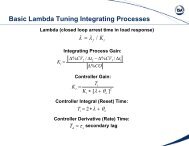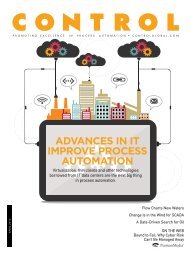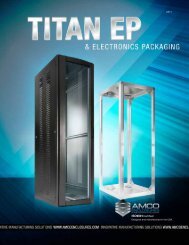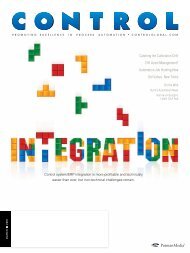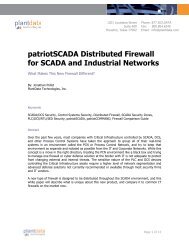April 2011 - Control Global
April 2011 - Control Global
April 2011 - Control Global
You also want an ePaper? Increase the reach of your titles
YUMPU automatically turns print PDFs into web optimized ePapers that Google loves.
The<br />
strongest<br />
link<br />
got<br />
stronger.<br />
Networking for your<br />
industrial system should be<br />
the easy part. Partnering with<br />
GarrettCom makes it simple and<br />
rock solid. Rely on our 21 years of expertise<br />
and proven solutions that include<br />
• Hardened products<br />
• Resilient networking<br />
• Ethernet, serial, WAN, wireless<br />
• Integrated PoE<br />
• Outstanding support<br />
With all the things you need to worry about,<br />
your network shouldn’t be one of them.<br />
Wireless<br />
router<br />
(510) 438-9071<br />
www.garrettcom.com<br />
S C A D A<br />
generation dispatchers and systems analysts oversee every turbine<br />
at every wind farm (and soon solar and biomass projects)<br />
throughout the country, around the clock. They monitor the<br />
performance and efficiency of every turbine. They keep an<br />
eye on approaching storms to warn technicians in the field to<br />
get to safety before harsh weather hits. They even have helped<br />
scientists conduct groundbreaking wildlife research. And they<br />
coordinate in real time with the nation’s various transmission<br />
system operators to insure grid reliability to help keep the<br />
lights on.<br />
The SCADA System<br />
A vital element of our operation is our newly developed<br />
SCADA system, supplied by PcVue (www.pcvuesolutions.<br />
com) and integrated by the Iberdrola Renewables team.<br />
Among other things, each wind turbine has a control box<br />
containing a PLC, power converter, control boards and<br />
I/O device. Sensors for wind speed, wind direction, shaft<br />
rotation speed and numerous other factors collect and<br />
transfer data to the PLC. By detecting the wind’s direction,<br />
the control system can use a motorized yaw gear to<br />
turn the entire wind turbine in the proper wind direction<br />
for maximum power generation. Our wind turbines<br />
are connected to a local area network (LAN) via a fiberbased,<br />
redundant ring connection. Although the turbines<br />
are designed to operate autonomously, they also are connected<br />
to a remote-control station running the control<br />
system that manages and collects data, adjusts turbine<br />
settings, and provides intelligent alarm, troubleshooting<br />
and reporting capabilities via our central data center and<br />
control facility in Portland.<br />
The National <strong>Control</strong> Center connects via long-haul<br />
networks to the plant-based systems and ultimately to the<br />
individual turbines, substations, meteorological stations<br />
and avian radar surveillance systems. It provides visibility<br />
for our operators to manage the behavior of all the wind<br />
turbines and all the wind farms as a whole. By keeping a<br />
record of the activity on a time-interval basis, the SCADA<br />
allows our operators to determine what adjustments and<br />
corrective actions, if any, need to be taken. It records energy<br />
output, availability and error signals, and we are designing<br />
the ability to control (among other things) power<br />
factor, voltage and reactive power production, allowing<br />
for the management of wind farms’ contributions to network<br />
voltage and frequency control. It also gives our operators<br />
the capability to manage power output based on<br />
real-time grid requirements.<br />
The SCADA communicates with the turbines via a<br />
communications network that almost always uses optical<br />
fibers. We have multiple turbine types in our fleet and<br />
each turbine supplier provides its own control/HMI system.<br />
We have found that the major advantages of using









